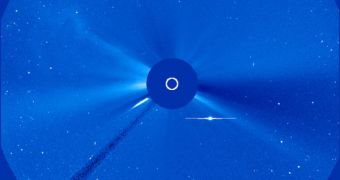According to new readings sent back by the NASA Solar and Heliospheric Observatory (SOHO), one unlucky comet is most likely going to experience a very unpleasant death shortly. It would appear that the ill-fated cosmic object is on a trajectory that will bring it very close to our Sun. Given the fact that most such space bodies are made up of rocks and ice, and that the temperature of the star is extremely high, astronomers believe that the comet has very little chances of escaping the fiery meet, Space reports.
The rock was found in the new SOHO images, and experts were surprised to see it there. Due to its proximity to the star, it is not visible to other observatories, but this NASA spacecraft is especially designed for this type of observations. The discovery was reported yesterday, March 12, on the website SpaceWeather.com. Scientists say that such events are not by far rare. They explain that estimates place the number of comets passing in the close vicinity of the Sun to around 1,600. While most of them keep a “safe” distance from the surface of the star, others simply pass too close, and either lose some of their mass to evaporation, or are destroyed completely.
Astronomers say that the newly discovered body is part of the Kreutz group of comets, which is known for passing remarkably close to the surface of the star. These bodies tend to swing at a distance of only several hundred thousand kilometers, which may seem like a long distance at first. However, in space terms, this amounts to almost nothing. The group to which this object belongs was named after the 19th century astronomer Heinrich Kreutz, who demonstrated that all the bodies in this group might be related. Experts now believe that they are the remnants of a much larger comet that broke into pieces only a few centuries ago.
The new comet could be observed only due to the remarkable way in which the SOHO is built. The telescope features a block on its main observatory, which means that it is capable of preventing direct exposure to sunlight. In return, it can make out solar weather very clearly, as well as objects that may lurk in the glare, undetectable in any other ways. By 2005, the observatory had detected more than 1,000 comets in the vicinity of the Sun. Before it was launched, in 1995, NASA's ground-based telescopes had only observed 16 such cosmic objects.

 14 DAY TRIAL //
14 DAY TRIAL //